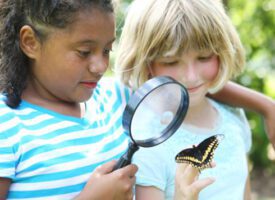
How can students keep learning science when the school day ends? The informal environments of after-school programs are a natural fit for hands-on science and developing inquiry skills—such as posing questions, designing scientific investigations, and creating explanations based on observations. After-school programs have the potential to boost students’ interest in science, technology, engineering and math (STEM).
To understand the support networks underlying current after-school science offerings, SRI conducted a five-year study funded by the National Science Foundation to examine the state of science learning opportunities in California’s After School and Education Safety (ASES) program.
As the country’s largest public after-school system, California provided us with a unique opportunity to examine programs in geographically dispersed environments that were urban and rural, diverse in demographic makeup, and differing in philosophies, approaches and resources. Studying the range of after-school programs in California made it possible to learn about the contexts and constraints relevant to after-school programs across the nation.
The findings and recommendations from the Afterschool Science Networks study—the most comprehensive research on science in publicly funded after-school programs to date – can be extrapolated to provide a framework for almost any after-school program that is looking to offer deeper science experiences for its students. While we found that only 22 percent of all the after-school program sites surveyed offered science frequently and with deep science experiences, by identifying the features that set these sites apart from the others, we were able to provide actionable and adoptable steps that can make a difference.
Partnerships Bring Deeper Science Learning Opportunities to Program Sites
One key feature associated with deep science learning was having an external partner that supported the program’s offerings. And we found that urban programs were no more likely to have partner support than rural ones. For example, a program in the San Francisco Bay Area might partner with “experts” such as the Lawrence Hall of Science, while a program in Humboldt might partner with the U.S. Forest Service or the local parks and recreation department. Both examples of partnerships were equally beneficial to the program site. If a program is in a rural area, it is just as advantageous to partner with a local college or a volunteer organization that’s working on a community garden – which makes enlisting support a realistic goal for most after-school programs.
Staff Knowledge of After-school Activities is Just as Beneficial as Knowledge of Science
Not surprisingly, programs with staff knowledgeable about science provided deeper science learning opportunities. Programs with staff knowledgeable in after-school activities had the same impact. Staff with a strong sense of youth development and how to get youth involved, engaged and asking questions were just as beneficial as those who had science knowledge. After-school programs have a powerful lever — they can train after-school staff in leading discussions, investigating ideas, and experimenting – all part of the inquiry nature of science.
Prioritizing Science Results in Stronger Programs
Another important feature of programs that provided deeper science experiences was designating a staff member to be in charge of science. This did not necessarily mean that the staff member was a science content expert, but instead was responsible for organizing and supporting science activities as part of his or her overall duties. Having someone on staff who championed and prioritized science resulted in stronger science programs that were offered regularly. This finding is significant because an after-school program can designate a staff member to be in charge of science without hiring a science expert, committing additional budget or making a significant change. An added benefit is that the designated staff member can set goals for their programs, such as learning how to design scientific investigations or exposing their students to science careers, and then align curriculum to the goals instead of conducting ad hoc science activities.
These examples of changes that after-school programs can implement quickly and with minimal budget or effort can significantly increase science learning opportunities. While there is more to explore around partners and the resources provided to after-school programs that meet the needs and interests of students and families in low-income and under-served communities, these recommendations can enable more students across the state, as well as nationwide, to experience the learning potential of after-school science.
This material is based upon work supported by the National Science Foundation under Award No. DRL-0917536. Any opinions, findings, and conclusions or recommendations expressed in this publication are those of the author(s) and do not necessarily reflect the views of the National Science Foundation.


